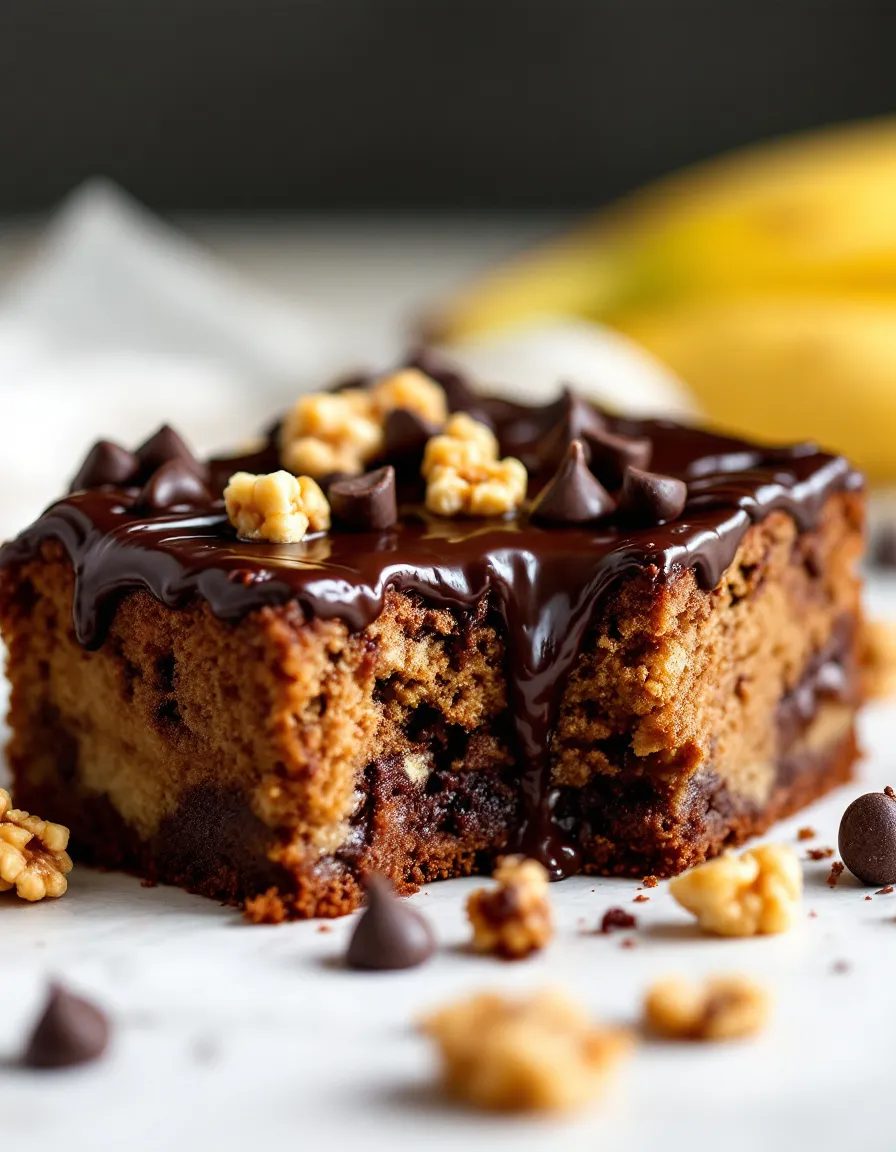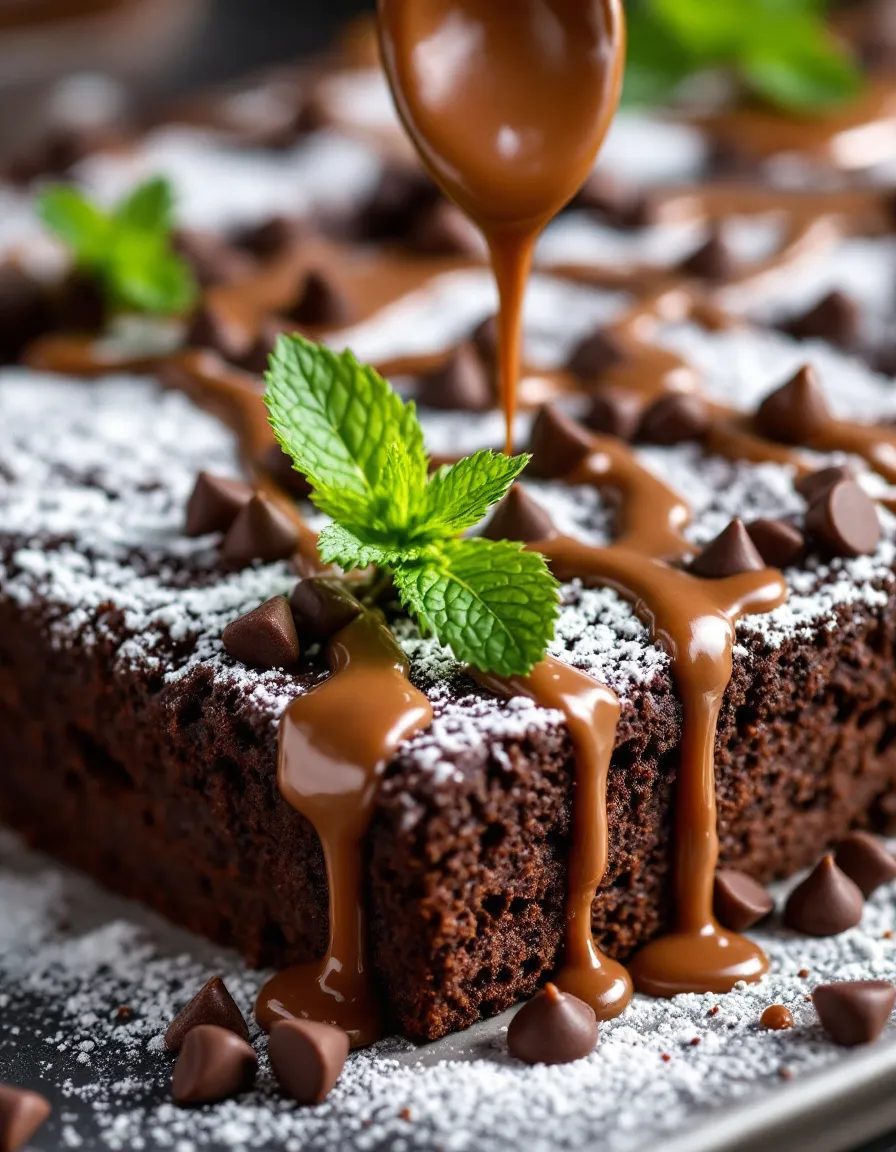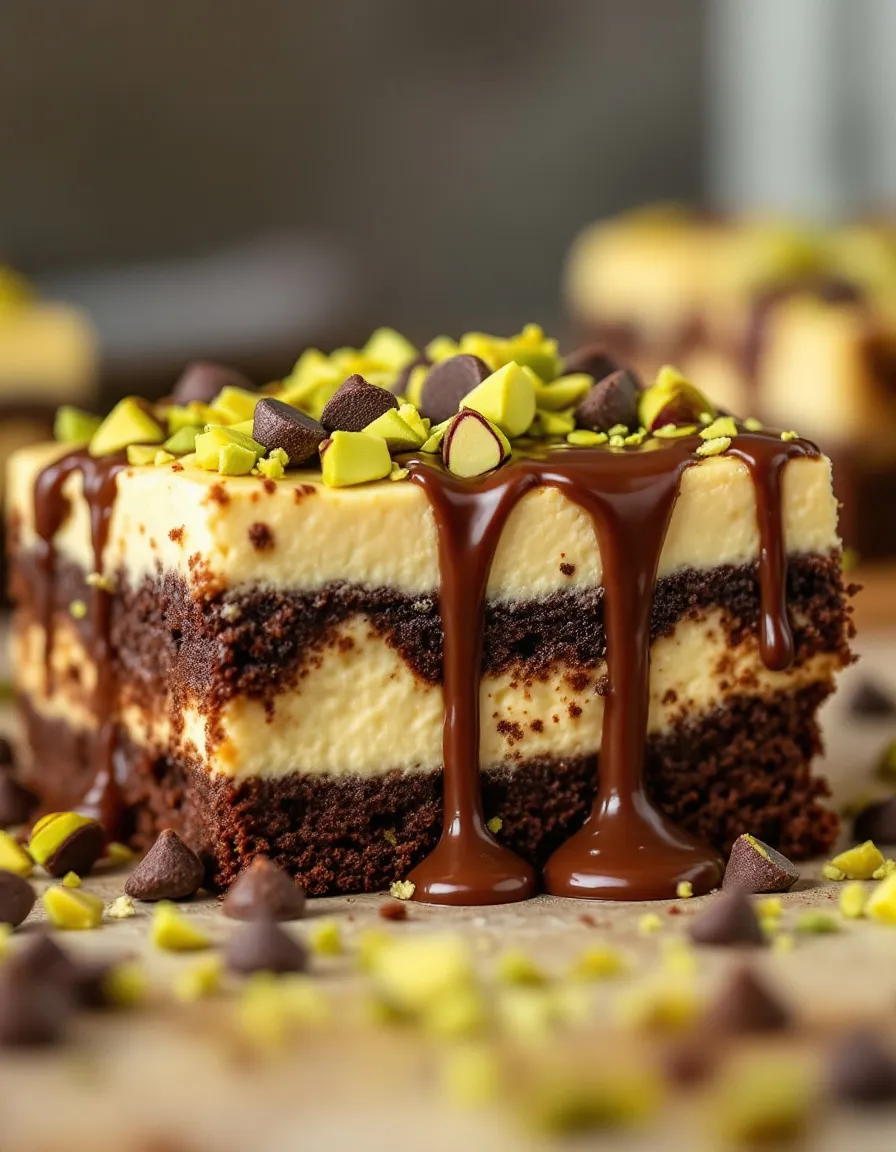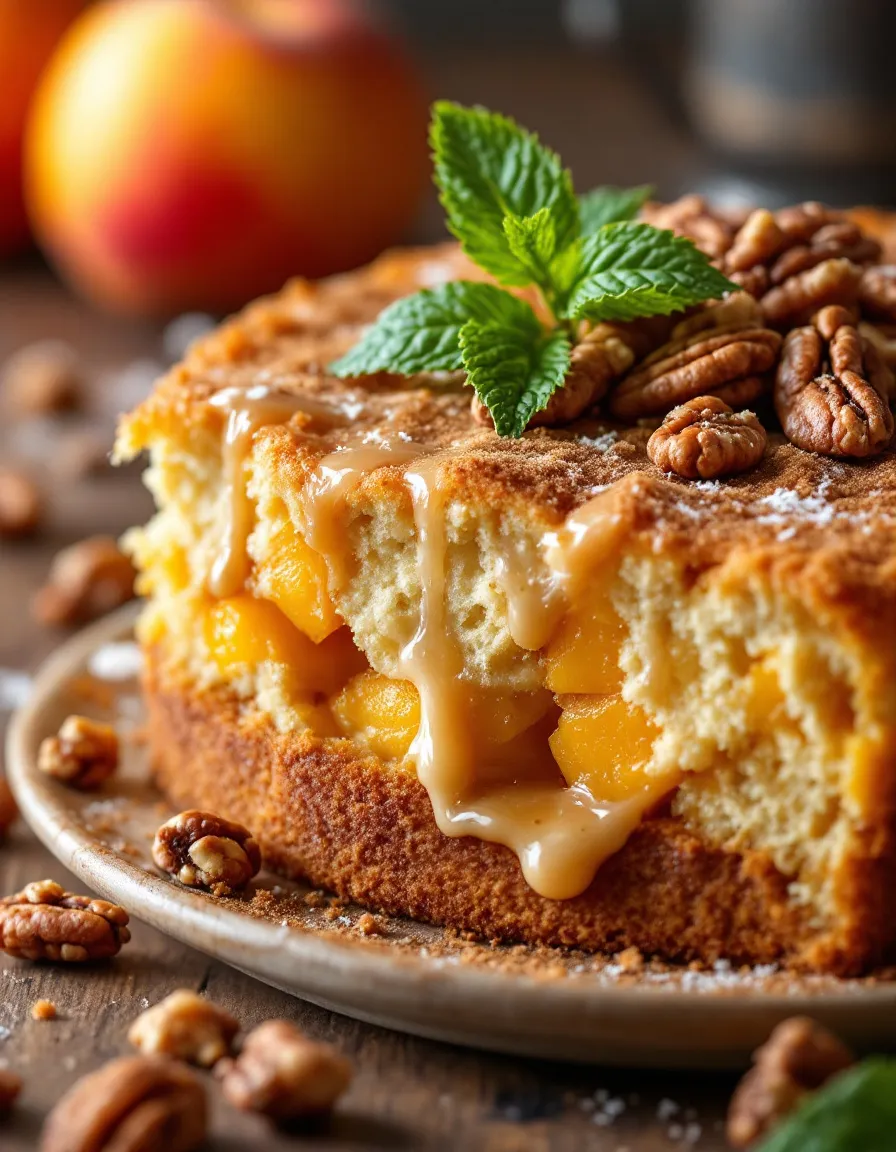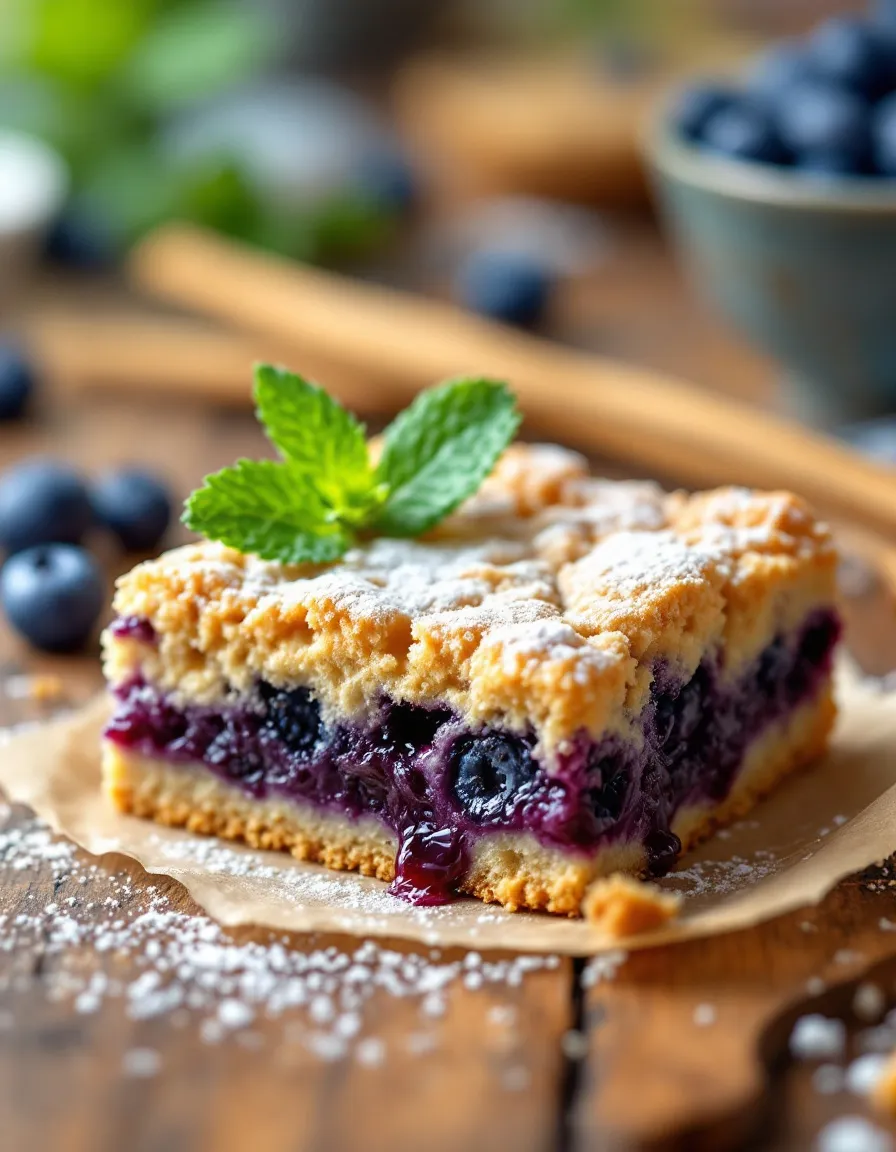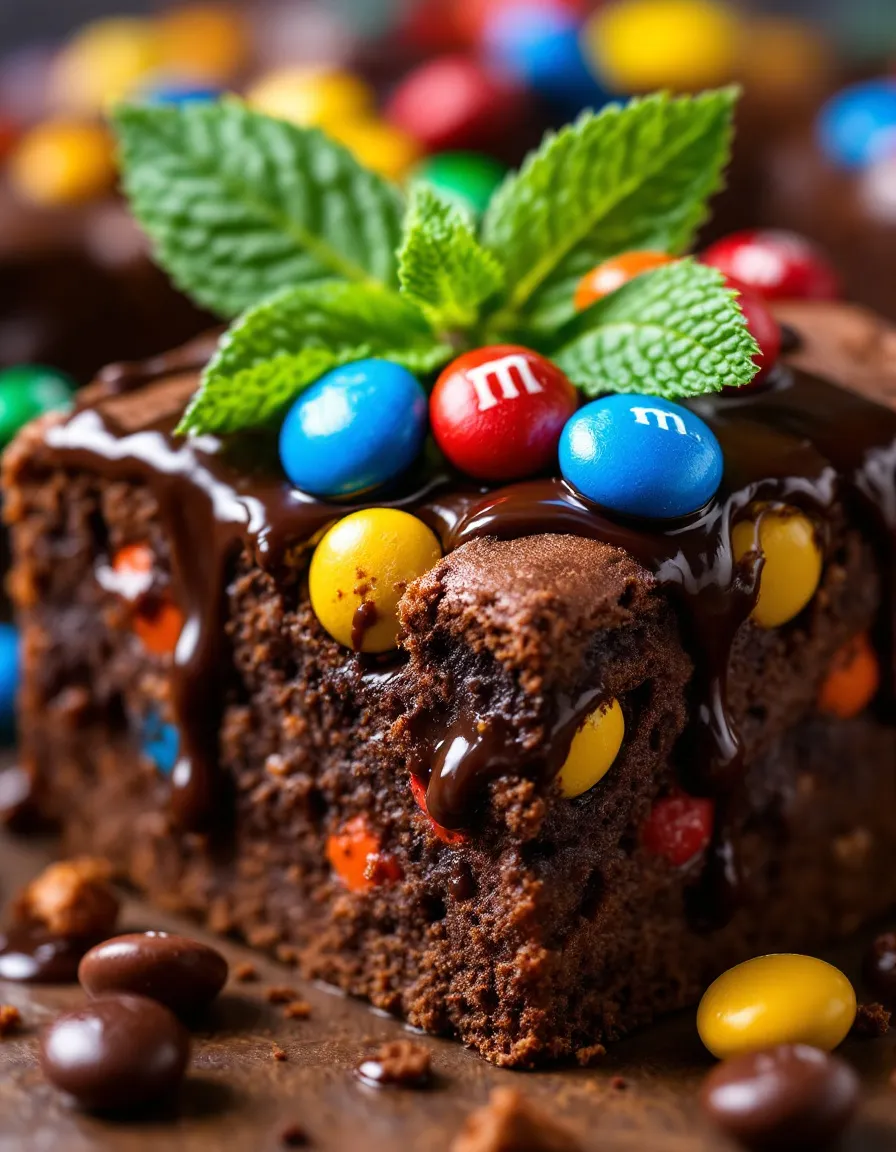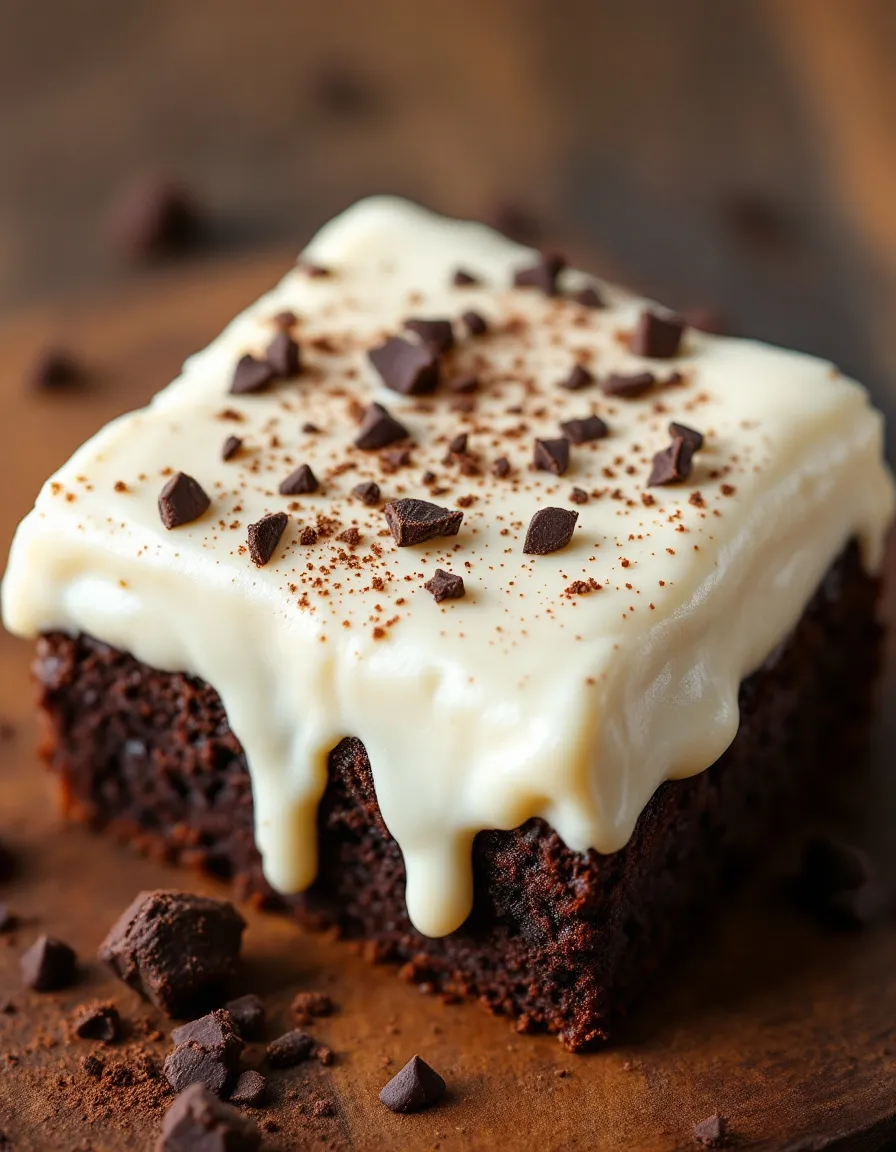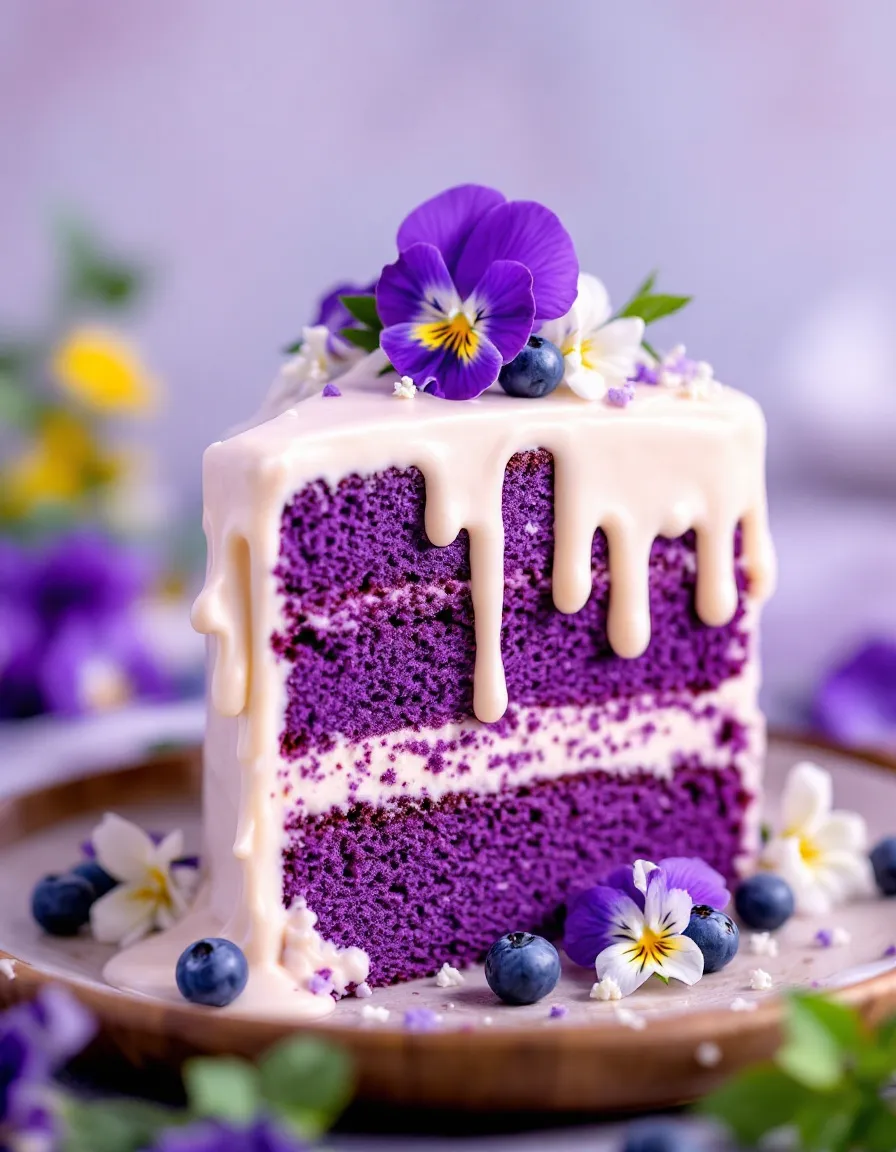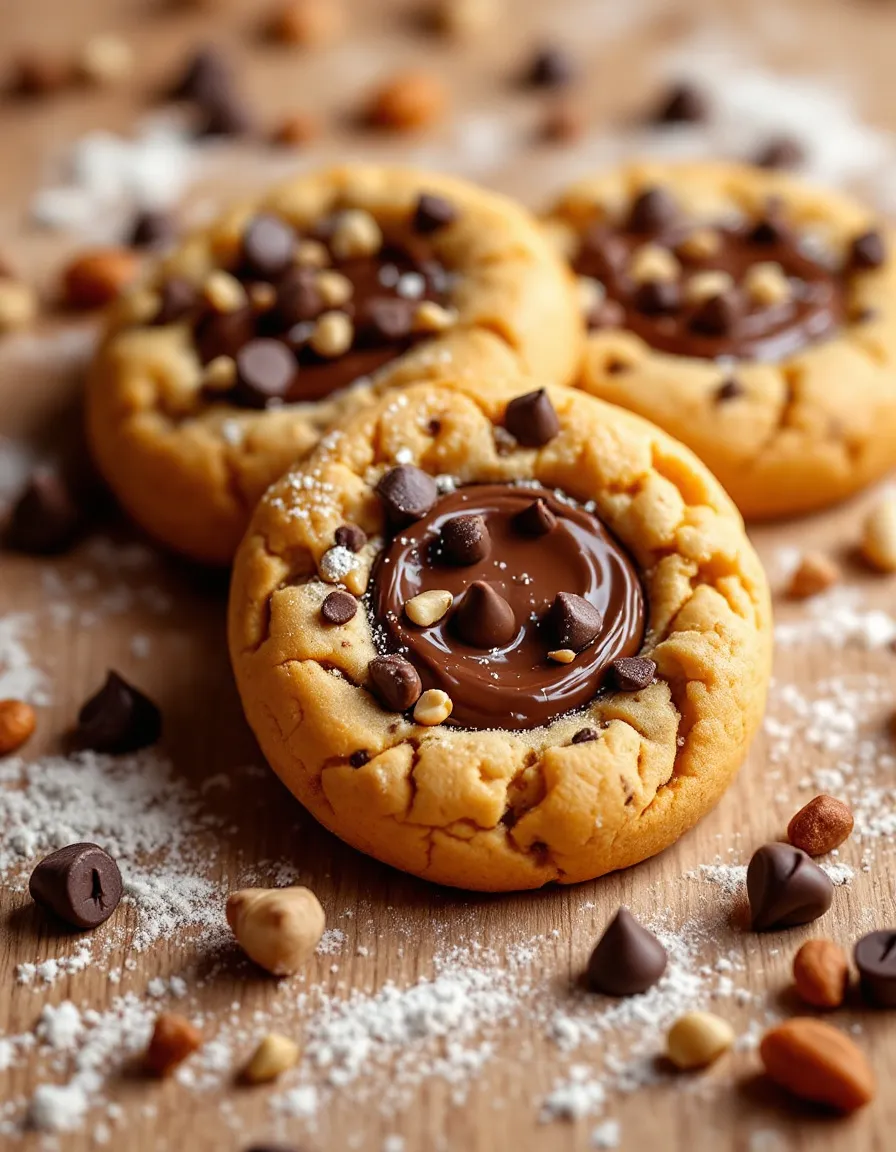Delicious Banana Bread Brownies: A Sweet Twist on Classic Flavors
Banana Bread Brownies are the perfect dessert for banana lovers looking for a unique spin on a timeless classic. Combining the moist, rich flavors of traditional banana bread with the chewy decadence of brownies, this recipe offers a delightful explosion of taste and texture. As you slice into these brownies, you’ll notice the beautiful speckles of mashed banana throughout, giving each bite a burst of sweet goodness.
These brownies are incredibly easy to make, requiring just a few staple ingredients you likely already have in your pantry. The warm aroma of bananas mingling with chocolate fills your kitchen, instantly creating a cozy atmosphere that calls for an afternoon tea party or a relaxing night in. The texture is a glorious blend of fudgy richness from the chocolate and the soft, cake-like nature of banana bread, making each piece simply irresistible.
Quick Recipe Highlights
- Flavor Profile: The distinct sweetness of ripe bananas combined with rich chocolate creates a harmonious blend of flavors that is both satisfying and indulgent.
- Texture: Expect a chewy, fudgy interior with a soft crumb, complemented by the slight caramelization on the edges that adds to the depth of flavor.
- Aroma: The delightful scent of baked bananas and chocolate wafts through the air, inviting everyone into the kitchen.
- Visual Appeal: The brownies boast a golden-brown exterior with dark chocolate chips shining through, making them visually appetizing.
- Skill Level Needed: This recipe requires only basic baking skills, making it ideal for novice bakers.
- Special Equipment: You will need a mixing bowl, baking pan, and a whisk or mixer for effortless preparation.
Recipe Overview
- Difficulty Level: This Banana Bread Brownies recipe is rated easy, making it approachable for bakers of all levels. The straightforward steps ensure anyone can successfully whip up this delightful treat.
- Category: These brownies are perfect as a dessert or a sweet treat for breakfast or brunch, merging both categories beautifully.
- Cuisine: While this recipe is rooted in American baking traditions, its use of bananas highlights the tropical fruit’s universal appeal.
- Cost: The estimated cost for ingredients is quite economical, making this recipe a budget-friendly option for families or gatherings.
- Season: Bananas are available year-round, but this recipe shines in the fall and winter months when cozy desserts are especially appreciated.
- Occasion: These brownies are ideal for casual get-togethers, potlucks, or even as a comforting treat to enjoy after a long day.
Why You’ll Love This Recipe
The irresistible taste and texture appeal will draw you to these Banana Bread Brownies time and time again. The fusion between the familiar banana bread and the rich, chocolatey brownie creates a dessert that is comforting yet indulgent. Each bite reveals the softness of banana and the sweetness of cocoa, crafting a beautiful balance that leaves you craving more.
The convenience of this recipe cannot be overstated. With minimal prep time and straightforward steps, you can bake a batch of brownies quickly, making them a perfect last-minute dessert option. Whether you’re bustling around preparing dinner or enjoying a quiet weekend, these brownies fit seamlessly into your schedule.
In addition to delightful flavors, these brownies provide nutritional advantages too. Bananas are an excellent source of potassium and fiber, contributing a healthier element to your indulgent treat. The chocolate adds antioxidants, making this dessert not just a guilty pleasure but a pleasantly satisfying one.
Socially, these brownies act as the centerpiece of any gathering, sparking conversations and delighting friends and family. Sharing a batch creates a warm atmosphere, whether offered as a gift or enjoyed among loved ones. Hosting friends becomes easier when you can serve a homemade treat that everyone raves about.
Finally, the affordability and accessibility of the ingredients make this recipe an everyday option. It’s easy to keep your pantry stocked with essentials like bananas, flour, and cocoa powder, ensuring you always have an inviting dessert at your fingertips that doesn’t break the bank.
Historical Background and Cultural Significance
Banana bread has its roots in the early 1930s when baking soda became widely available as a leavening agent. As families began to embrace the new cooking method, mashed bananas emerged as a popular addition, taking advantage of overripe fruit and minimizing waste. This paved the way for the evolution of banana bread recipes, eventually inspiring the creation of banana desserts in various forms.
Culturally, banana bread has become synonymous with comfort food in many households, particularly in the United States. It symbolizes the resourcefulness of home bakers, making use of overripe bananas to create something delicious and enjoyable. The recipe often gets passed down through generations, turning it into a cherished tradition.
The banana bread brownie adaptation shows how classic recipes can evolve to meet contemporary tastes. Combining the fudge-like texture of brownies with the moistness of banana bread has resulted in a new dessert that retains the beloved qualities of both. This evolution reflects changing culinary trends, where innovative recipes capture the interest of home bakers.
Regionally, you can find variations of banana desserts influenced by local ingredients. Some cultures incorporate spices like cinnamon or nutmeg to enhance flavor profiles, while others may add nuts or dried fruit, showcasing the diverse range of options that this beloved treat can provide.
Ingredient Deep Dive
Bananas stand as the star ingredient in this recipe, rich in history and significance. Native to Southeast Asia, bananas have spread globally and are now embraced in various culinary traditions. The fruit is packed with nutrients, offering vitamins B6 and C, as well as fiber, which supports digestive health. When selecting bananas for baking, choose ones that are speckled and firm but not overly ripe for the best results. Store them at room temperature until you’re ready to use and consider freezing extras for later baking.
Flour, the cornerstone of many baking recipes, provides structure and texture. Whole wheat flour can add a nutty flavor and increased fiber, while all-purpose flour offers a light texture, allowing the banana’s flavor to shine. When purchasing flour, opt for brands that offer freshness guarantees and consider storage in an airtight container to maintain its quality. Should you need a gluten-free option, almond or coconut flour can serve as fantastic substitutes, though they may alter the final texture slightly.
Cocoa powder contributes the deep chocolate flavor that complements the sweetness of the bananas. High-quality cocoa powder boasts rich flavor and is often more concentrated than regular varieties. Choose unsweetened cocoa powder to maintain the balance of sweetness in your brownies. Store it in a cool, dark place for longevity, and feel free to experiment with dark chocolate variations for an intense flavor.
Sugar plays a vital role in balancing sweetness and moisture; you can opt for alternatives like brown sugar for a deeper flavor. Consider natural sweeteners like honey or maple syrup for a healthier version, but be aware that you may need to adjust other liquids in the recipe. Always check for substitutions that align with your dietary preferences and nutritional goals.
Eggs bind the ingredients and contribute to the overall fluffiness of the brownies. They also provide moisture and richness, enhancing the final product’s texture. For those seeking egg replacements, consider flaxseed meal or applesauce, though this will slightly impact the structure and density of the brownies. Always experiment and find what best suits your dietary needs and textures you enjoy.
Common Mistakes to Avoid
- Overmixing the batter can lead to tough brownies. Aim for just combined ingredients.
- Using under-or overripe bananas affects both the flavor and moisture. Ensure bananas are perfectly ripe with brown spots for optimal taste.
- Not measuring flour correctly can result in dry or dense brownies. Use the spoon-and-level method for accurate measurement.
- Skipping the parchment paper lining can cause sticking. Always line your pan for easy removal and clean-up.
- Opening the oven door while baking lets out heat, leading to uneven baking. Avoid peeking until the recommended baking time.
- Misjudging cooling time means these brownies may crumble when cut. Let them cool in the pan for at least 15 minutes.
- Baking in a pan that’s too small could lead to overflow. Use the recommended size for best results.
- Overbaking dries out the brownies. Keep an eye on them and perform the toothpick test to gauge doneness.
- Storing brownies in the fridge can lead to increased dryness. Instead, store them at room temperature in an airtight container.
- Inefficient chocolate melting can lead to clumps. Always melt chocolate slowly to ensure smooth consistency.
Essential Techniques
Mastering the banana bread brownie recipe hinges on a few key techniques. First, understanding the role of bananas is crucial; they should be mashed thoroughly to blend seamlessly into the batter, imparting moisture without lumps. Use a fork or potato masher to achieve a smooth consistency.
Next, learn the importance of folding ingredients. This technique helps incorporate dry and wet ingredients without overmixing. Gently lift and fold the mixtures to maintain airiness while ensuring every bite is flavor-packed. Be mindful of visual cues; the batter should be slightly lumpy but not dry after combining.
Another essential skill is understanding how to prepare your pan correctly. Lining the pan with parchment eliminates sticking and ensures easy removal. Additionally, preheating your oven and using an oven thermometer helps maintain ideal baking temperatures, leading to evenly baked brownies.
Pro Tips for Perfect Banana Bread Brownies
Use the ripest bananas possible to maximize sweetness and moisture. The browner, the better!
Experiment with chocolate variations; dark chocolate chips can enhance richness and add depth.
Top with nuts or sprinkles for added texture and flavor; walnuts or pecans work great.
Chill the brownies for a fudgier, denser texture; they cut more cleanly and are easy to handle.
Use a pizza cutter for neat slicing; it glides through brownies without tearing.
Add a pinch of salt to enhance the sweetness and round out the flavors.
Let the brownies cool completely for best flavor development, as they continue to set as they cool.
Consider drizzling melted chocolate on top for a beautiful presentation and extra indulgence.
Variations and Adaptations
Regional variations of banana bread brownies can introduce exciting new flavors; considering adding spices like cinnamon or nutmeg to the batter can introduce warm aromas resembling traditional banana bread. Seasonal adaptations such as adding chopped apples or pumpkin puree can align the dish with festive flavors.
For those with dietary restrictions, there are multiple modification opportunities! Going gluten-free is as simple as substituting with almond or oat flour. For a vegan version, replace eggs with flaxseed meal and use non-dairy chocolate chips.
Experimenting with texture modifications can yield delightful results; blending an extra banana into the batter can make the brownies richer and softer, while adding oats could give them a heartier chew. Furthermore, consider alternative toppings—like coconut flakes or caramel drizzle—to elevate presentation and flavor.
Serving and Presentation Guide
Presentation plays a vital role in how we perceive food. For banana bread brownies, consider cutting them into uniform squares for an appealing presentation. Using a platter with a colorful cloth beneath can make the brownies pop visually.
To elevate their look, consider garnishing with fresh banana slices or a dusting of powdered sugar that contrasts against the dark chocolate hue. Traditional accompaniments like ice cream or whipped cream can enhance enjoyment, offering a creamy contrast to the dense brownies.
Temperature also plays a significant role: serve them warm for a melty chocolate experience or chilled for a fudgier texture. Portion control is important too; aim for reasonable serving sizes to maintain balance, allowing everyone to enjoy without overindulgence.
Wine and Beverage Pairing
Banana bread brownies pair fantastically with dessert wines like a late-harvest Riesling, which complements sweet and fruity flavors well. The sweetness balances the chocolate, enhancing the entire experience.
For those preferring non-alcoholic alternatives, try pairing the brownies with a warm cup of chai tea; the spices in the chai resonate beautifully with the banana flavor.
If coffee strikes your fancy, a medium roast coffee works wonders; its acidity and depth harmonize beautifully with the brownies’ richness. Serve coffee slightly chilled to maintain a refreshing aspect without detracting from the dessert’s sweetness.
Storage and Shelf Life
Proper storage is key to maintaining the freshness of your banana bread brownies. Allow them to cool completely before transferring them to an airtight container to keep them moist.
At room temperature, these brownies will last approximately 3-4 days. If you wish to extend their shelf life, consider freezing them. Wrap each brownie individually in plastic wrap, then store them in a freezer-safe container. They can last up to three months in the freezer.
Look out for signs of spoilage, including changes in texture or an off smell. To reheat, simply microwave a brownie for about 10-15 seconds for a warm, fresh-tasting treat. Thaw frozen brownies in the refrigerator overnight for optimal texture.
Make Ahead Strategies
Planning ahead is conducive to enjoying these Banana Bread Brownies even on busy days. The batter can be prepared and stored in the fridge for up to 24 hours before baking; this allows the flavors to meld beautifully, enhancing taste.
Alternatively, you can bake the brownies in advance and store them in an airtight container at room temperature. This is perfect for gatherings, guaranteeing you’ll have a delectable dessert ready to serve.
Should you wish to add fresh toppings, consider doing so right before serving. This keeps them crisp and visually appealing.
Being aware of which ingredients can be prepped ahead of time can save time while allowing you to enjoy the fruits of your labor later.
Scaling Instructions
Scaling this banana bread brownie recipe can help accommodate varying serving sizes.
To halve the recipe, simply reduce all ingredient amounts by 50%, taking care to use an appropriately sized pan.
When doubling or tripling the recipe, ensure you have larger baking pans, as this will demand a longer baking time.
Inspect doneness frequently; larger quantities may require adjustments of 5-10 extra minutes in the oven.
Further, store any excess brownies separately, ensuring they are completely cooled before wrapping and stashing away.
Nutritional Deep Dive
The macro breakdown of a typical serving of these Banana Bread Brownies highlights their delicious yet moderate caloric density. The balance of carbohydrates from sugar and flour, protein from eggs, and healthy fats in optional additives creates a satisfying treat.
Micronutrient-wise, these brownies offer potassium-rich bananas and iron from the chocolate, adding valuable elements to your diet. The experiment of portioning can aid in mindful eating strategies, as enjoying small servings of indulgent treats can satisfy cravings without excessive bulk.
Moreover, being aware of serving suggestions can be helpful for those on weight management journeys. Pairing brownies with fresh fruit can add volume and nutrients with fewer calories.
Dietary Adaptations
Creating dietary adaptations of this recipe ensures everyone can enjoy these delicious brownies. For a gluten-free twist, substitute all-purpose flour with almond or coconut flour, keeping in mind that adjustments in moisture levels may be necessary.
Going dairy-free can be easily accomplished by opting for coconut oil and non-dairy dark chocolate. If you’re vegan, simple swaps like unsweetened applesauce or flaxseed meal will replace eggs efficiently while maintaining balance.
For those on low-carb or keto diets, consider using almond flour and a sugar substitute like erythritol to cater to specific dietary needs without sacrificing flavor.
Paleo followers can simply replace sugar with raw honey or maple syrup and opt for coconut flour to stay aligned with their dietary preferences.
Include appropriate substitutions and eliminate ingredients while reaching the same flavors and textures for an inclusive recipe.
Troubleshooting Guide
Common texture problems, like dryness, often stem from incorrect baking times. Overbaking can cause brownies to become crumbly; aim for a toothpick inserted in the center to come out with moist crumbs attached.
For flavor imbalance, consider the sweetness level; add a pinch of salt or vanilla extract to enhance chocolate notes. If the banana flavor is too subtle, try using overripe bananas, which concentrate sweetness.
When faced with equipment challenges, ensure your oven is calibrated correctly; uneven baking might indicate discrepancies in temperature settings.
If you need substitutions, remember that replacing flour with nut or coconut flour requires moisture adjustments. Similarly, when switching chocolate types, continuously track sweetness levels.
Finally, timing issues can arise from opening the oven door frequently; try to keep the door closed for better, even baking results.
Recipe Success Stories
Community feedback surrounding these Banana Bread Brownies highlights the versatility and delicious nature of the recipe. Users often share their variations, like adding Nutella or caramel swirls, which has led to raving reviews across the board.
Those who have attempted this recipe frequently mention how it has become a family favorite, expressing joy in seeing younger generations enjoying the sweet treat.
Photography suggestions also emerge, with many recommending natural light for capturing the beautifully layered textures of the brownies.
Readers recommend experimenting with different flavors and add-ins, from peanut butter to fruit-infused varieties, leading to delightful stories of successful adaptations that have become household staples.
Frequently Asked Questions
You can use ground flaxseed meal combined with water (1 tablespoon of flaxseed with 2.5 tablespoons of water equals one egg) or unsweetened applesauce (¼ cup per egg) for an effective replacement.
Check doneness by inserting a toothpick into the center; if it comes out with moist crumbs attached, they’re ready. It’s better to slightly underbake, as they will continue to set after being removed.
Absolutely! Wrap each brownie tightly in plastic wrap and store in a freezer-safe container or bag. They can be frozen for up to three months. Thaw overnight in the fridge before serving.
Yes! Chopped walnuts or pecans can be added to the batter before baking for added crunch and flavor. Just ensure to adjust baking time if needed.
After cooling, store brownies in an airtight container at room temperature for up to 4 days. For longer shelf life, consider freezing as mentioned previously.
Absolutely! Simply double or triple the ingredients as necessary, but use larger baking pans. Just be attentive to potential adjustments in baking time.
Use semi-sweet or dark chocolate for a rich flavor. If you prefer milk chocolate, balance the sweetness in the other ingredients as needed.
Yes, you can mix the wet ingredients in one bowl, then add dry ingredients gradually. Just make sure to thoroughly combine while minimizing transfer to keep it simple.
Cooling brownies completely ensures cleaner cuts. Use a warm knife for the cleanest slices, wiping it between cuts to keep edges neat.
While you can substitute white chocolate, keep in mind it will add extra sweetness. Adjust other sweeteners in the batter accordingly for flavor balance.
Additional Resources
For those who enjoy baking with bananas, consider exploring related recipes such as classic banana bread, banana muffins, or even banana pancakes. Each recipe plays with the delightful flavors that bananas bring to the table.
Additionally, keep an eye out for ingredient information that highlights the nutritional value of bananas, flour types, and the benefits of using natural sweeteners. Diving deeper into these topics can enhance your understanding of cooking and baking with intention.
Technique guides on how to properly mash bananas or how to melt chocolate effectively are essential for attaining perfect results in this and other recipes.
Explore equipment recommendations for essential baking tools, such as high-quality mixing bowls and versatile pan sizes to make your baking experience seamless.
Join the Conversation
We invite you to share your own variations of this Banana Bread Brownies recipe! Connect with us on social media and show off your creations.
Post your photography tips or recipe adaptations and engage with our community. We encourage discussions about your favorite ways to enjoy these brownies, be it with a scoop of ice cream or alongside coffee.
Your experiences not only inspire others but foster a community of baking enthusiasts eager for new ideas. Join in and spread the love for homemade desserts!
The Recipe
Banana Bread Brownies
Serves: 12 servings
Prep Time: 15 mins
Cook Time: 30 mins
Total Time: 45 mins
Kitchen Equipment Needed
- Mixing bowl
- Baking pan (9×9 inches)
- Whisk or electric mixer
- Parchment paper
- Measuring cups and spoons
- Spatula
Ingredients
- 3 ripe bananas, mashed
- 1 cup sugar
- ½ cup unsalted butter, melted
- 2 large eggs
- 1 tsp vanilla extract
- 1 cup all-purpose flour
- 1/3 cup cocoa powder
- ½ tsp baking soda
- ½ tsp salt
- 1 cup chocolate chips
Directions
- Preheat your oven to 350°F (175°C) and line a 9×9 inch baking pan with parchment paper.
- In a large mixing bowl, combine the mashed bananas, melted butter, and sugar, and mix until well incorporated.
- Add eggs and vanilla extract, whisking until smooth.
- In a separate bowl, whisk together the flour, cocoa powder, baking soda, and salt.
- Gradually add the dry ingredients to the wet mixture, folding until just combined; avoid overmixing.
- Stir in the chocolate chips, then pour the batter into the prepared pan, spreading it evenly.
- Bake for 30 minutes or until a toothpick inserted comes out with a few moist crumbs.
- Allow cooling in the pan for at least 15 minutes before slicing and serving.
Recipe Notes
- For an extra chocolatey flavor, consider adding an additional 1/4 cup of cocoa powder.
- Make sure the bananas are very ripe for maximum sweetness.
- Feel free to substitute half of the all-purpose flour with whole wheat flour for a healthier twist.
- Keep an eye on the brownies towards the end of the baking time to prevent overbaking.
